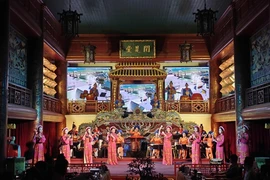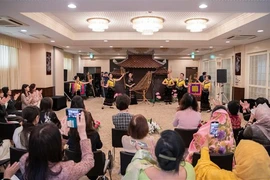Representatives from six provinces and cities participated in showcasing the traditional rituals associated with their respective traditions that utilize the Neu Pole as a central symbol.
Dak Lak province presented the pole performance intertwined with health-related rituals of the E De ethnic group.
In the E De language, the Neu Pole is referred to as "Gong Drai," resembling a connecting thread to the spiritual realm, seeking blessings for abundant health for everyone.
In Son La province, the Neu Pole is associated with the White Thai people and is erected during the "Head Tra" ceremony, showcasing humanistic values and honouring traditional healers.
Meanwhile, the tradition in Da Nang city is associated with the Co Tu ethnic community, serving as a cultural symbol and an integral element in various ceremonial offerings.
The practice in the Black Thai ethnic group in Lai Chau province is associated with the Kin Pang Then festival. Here, "Then" refers to the spiritual leader, considered a divine being sent down to Earth to aid humanity in its struggles and it provides assistance to communicate with the deities.
In Thank Hwa province, the Neu Pole is linked with the Muong people. This ritual signifies the expulsion of negativity from the past year and the welcoming of positive blessings in the coming year.
In Quang Nam province, the same tradition belongs to the Ca Dong ethnic community. The Ca Dong people believe that the Neu Pole serves as a sacred space where deities and ancestors gather to participate in festivals and ceremonies.
The festival will span three days from November 23 to 25, featuring various cultural, artistic, and sports exchange activities between regions and localities. It aims to preserve and promote the rituals, beliefs, and traditional art forms of ethnic minorities within the Vietnamese community./.



















